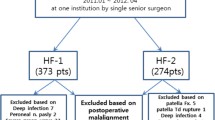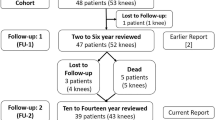Abstract
Implants designed for enhanced flexion offer the prospect of improved function after total knee replacement (TKR). Whereas most studies evaluating these implants have focused on the range of knee flexion achieved, this study investigated the quality of function in deep knee flexion. The influences of residual pain and maximum flexion angle on function in deep knee flexion were also examined. Eighty-three patients (100 knees) were prospectively followed for 1 year after TKR with a rotating-platform posterior-stabilized high-flexion prosthesis. Range of motion was measured and Knee Society scores were calculated. A questionnaire evaluated residual knee pain and function in high-flexion activities. Mean Knee Society score was 95, and mean knee flexion was 125°, yet 20% of patients could neither kneel, nor squat, nor sit on their heels. Fifty-seven percent were able to kneel without significant difficulty; 69% were able to squat without significant difficulty; and 46% were able to sit on their heels without significant difficulty. Function in deep flexion correlated with pain scores but did not correlate with knee flexion angles or Knee Society scores. Results 1 year after TKR with a rotating-platform posterior-stabilized high-flexion prosthesis are encouraging, but one in five patients remain significantly limited in high-flexion activities.


Similar content being viewed by others
References
Anouchi YS, McShane M, Kelly F Jr, Elting J, Stiehl J, Range of motion in total knee replacement. Clin. Orthop. 1996; 331: 87–92
Emerson RH Jr, Ayers C, Head WC, Higgins LL, Surgical closing in primary total knee arthroplasties: flexion versus extension. Clin. Orthop. 1996; 331: 74–80
Ranawat CS, Luessenhop CP, Rodriguez JA, The press-fit condylar modular total knee system. Four-to-six-year results with a posterior-cruciate-substituting design. J. Bone Joint Surg. Am. 1997; 79: 342–348
Buehler KO, Venn-Watson E, D’Lima DD, Colwell CW Jr., The press-fit condylar total knee system: 8- to 10-year results with a posterior cruciate-retaining design. J. Arthroplasty. 2000; 15: 698–701
Chen AL, Mujtaba M, Zuckerman JD, Jeong GK, Joseph TN, Wright K, Di Cesare PE (2001) Midterm clinical and radiographic results with the Genesis I total knee prosthesis. J. Arthroplasty. 2001; 16: 1055–1062
Ritter MA, Harty LD, Davis KE, Meding JB, Berend ME, Predicting range of motion after total knee arthroplasty: clustering, log-linear regression, and regression tree analysis. J. Bone Joint Surg. Am. 2003; 85: 1278–1285
Barrington JW, Sah A, Malchau H, Burke DW, Contemporary cruciate-retaining total knee arthroplasty with a pegged tibial base plate. Results at a minimum of ten years. J. Bone Joint Surg. Am. 2009; 91: 874–878
Lachiewicz PF, Soileau ES, Fifteen-year survival and osteolysis associated with a modular posterior stabilized knee replacement. A concise follow-up of a previous report. J. Bone Joint Surg. Am. 2009; 91: 1419–1423
Kim YK, Sohn KS, Kim JS, Range of motion of standard and high-flexion posterior stabilized total knee prostheses. A prospective, randomized study. J. Bone Joint Surg. Am. 2005; 87: 1470
Gupta SK, Ranawat AS, Shah V, Zikria BA, Zikria JF, Ranawat CS, The P.F.C. sigma RP-F TKA designed for improved performance: a matched-pair study. Orthopedics 2006; 29(9 Suppl): S49
Weeden SH, Schmidt R, A randomized, prospective study of primary total knee components designed for increased flexion. J. Arthroplasty. 2007; 22: 349
Bin SI, Nam TS, Early results of high-flex total knee arthroplasty: comparison study at 1 year after surgery. Knee Surg. Sports Traumatol. Arthrosc. 2007; 15: 350–355
Minoda Y, Aihara M, Sakawa A, Fukuoka S, Hayakawa K, Ohzono K, Range of motion of standard and high-flexion cruciate retaining total knee prostheses. J. Arthroplasty. 2009; 24(5): 674–680
Huang HT, Su JY, Wang GJ, The early results of high-flex total knee arthroplasty: a minimum of 2 years of follow-up. J. Arthroplasty. 2005; 20(5): 674
Seon JK, Song EK, Lee JY, Comparison of range of motion of high-flexion prosthesis and mobile bearing prosthesis in total knee arthroplasty. Orthopaedics 2005; 28(10): s1247
Nutton RW, van der Linden ML, Rowe PJ, Gaston P, Wade FA, A prospective randomised double-blind study of functional outcome and range of flexion following total knee replacement with the NexGen standard and high flexion components. J. Bone Joint Surg. Br. 2008; 90: 37–42
Seon JK, Park SJ, Lee KB, Yoon TR, Kozanek M, Song EK, Range of motion in total knee arthroplasty: a prospective comparison of high-flexion and standard cruciate-retaining designs. J. Bone Joint Surg. Am. 2009; 91: 672–679
Kim TK, Chang CB, Kang YG, Kim SJ, Seong SC, Causes and predictors of patient’s dissatisfaction after uncomplicated total knee arthroplasty. J. Arthroplasty. 2009; 24(2): 263–271
Han HS, Kang SB, Yoon KS, High incidence of loosening of the femoral component in legacy posterior stabilised-flex total knee replacement. J. Bone Joint Surg. Br. 2007; 89: 1457–1461
Miner AL, Lingard EA, Wright EA, Sledge CB, Katz JN, Kinemax Outcomes Group. Knee range of motion after total knee arthroplasty: How important is this as an outcome measure? J. Arthroplasty. 2003; 18: 286–294
Meneghini RM, Pierson JL, Bagsby D, Ziemba-Davis M, Berend ME, Ritter MA, Is there a functional benefit to obtaining high flexion after total knee arthroplasty? J. Arthroplasty. 2007; 22: 43–46
Insall JN, Dorr LD, Scott RD, Scott WN, Rationale of the Knee Society clinical rating system. Clin. Orthop. 1989; 248: 13–14
Parvataneni HK, Ranawat AS, Ranawat CS, The use of local periarticular injections in the management of postoperative pain after total hip and knee replacement: a multimodal approach. Instr. Course Lect. 2007; 56: 125–131
Ewald FC, The Knee Society total knee arthroplasty roentgenographic evaluation and scoring system. Clin. Orthop. 1989; 248: 9–12
Rasquinha VJ, Ranawat CS, Cervieri CL, Rodriguez JA, The press-fit condylar modular total knee system with a posterior cruciate-substituting design a concise follow-up of a previous report. J. Bone. Joint. Surg. Am. 2006; 88: 1006–1010
Ritter MA, Berend ME, Harty LD, Davis KE, Meding JB, Keating EM, Predicting range of motion after revision total knee arthroplasty: clustering and log-linear regression analyses. J. Arthroplasty. 2004; 19: 338–343
Ranawat AS, Gupta SK, Ranawat CS, The P.F.C. sigma RP-F Total knee arthroplasty: designed for improved performance. Orthopedics. 2006; 29(9 Suppl): S28
Kim Y-H, Choi Y, Kwon OR, Kim J-S, Functional outcome and range of motion of high-flexion posterior cruciate-retaining and high-flexion posterior cruciate-substituting total knee prostheses. A Prospective, Randomized Study. J. Bone Joint Surg. Am. 2009; 91: 753–760
Argenson JN, Parratte S, Ashour A, Komistek RD, Scuderi GR, Patient-reported outcome correlates with knee function after a single-design mobile-bearing TKA. Clin. Orthop. 2008; 466: 2669–2676
Ritter MA, Lutgring JD, Davis KE, Berend ME, The effect of postoperative range of motion on functional activities after posterior cruciate-retaining total knee arthroplasty. J. Bone Joint Surg. Am. 2008; 90: 777–784
Mahoney OM, McClung CD, dela Rosa MA, Schmalzried TP, The effect of total knee arthroplasty design on extensor mechanism function. J. Arthroplasty. 2002; 17: 416–421
Bullens PHJ, van Loon CJM, Malefijt MC, Laan RFJM, Veth RPH, Patient satisfaction after total knee arthroplasty: a comparison between subjective and objective outcome assessments. J. Arthroplasty. 2001; 16(6): 740
Mancuso CA, Sculco TP, Wickiewicz TL, Jones EC, Robbins L, Warren RF, Williams-Russo P, Patients’ expectations of knee surgery. J. Bone Joint Surg. Am. 2001; 83: 1005
Noble PC, Conditt MA, Cook KF, Mathis KB, The John Insall Award: patient expectations affect satisfaction with total knee arthroplasty. Clin. Orthop. 2006; 452: 35–43
Author information
Authors and Affiliations
Corresponding author
Additional information
One or more of the authors (ASR, CSR) have received funding from DePuy, a Johnson & Johnson Company (Warsaw, IN, USA).
Each author certifies that his or her institution has approved the reporting of these cases, that all investigations were conducted in conformity with ethical principles of research, and that informed consent for participating in the study was obtained.
Level of Evidence: Level IV: Prospective Case Series.
Rights and permissions
About this article
Cite this article
Hepinstall, M.S., Ranawat, A.S. & Ranawat, C.S. High-Flexion Total Knee Replacement: Functional Outcome at One Year. HSS Jrnl 6, 138–144 (2010). https://doi.org/10.1007/s11420-009-9150-7
Received:
Accepted:
Published:
Issue Date:
DOI: https://doi.org/10.1007/s11420-009-9150-7




